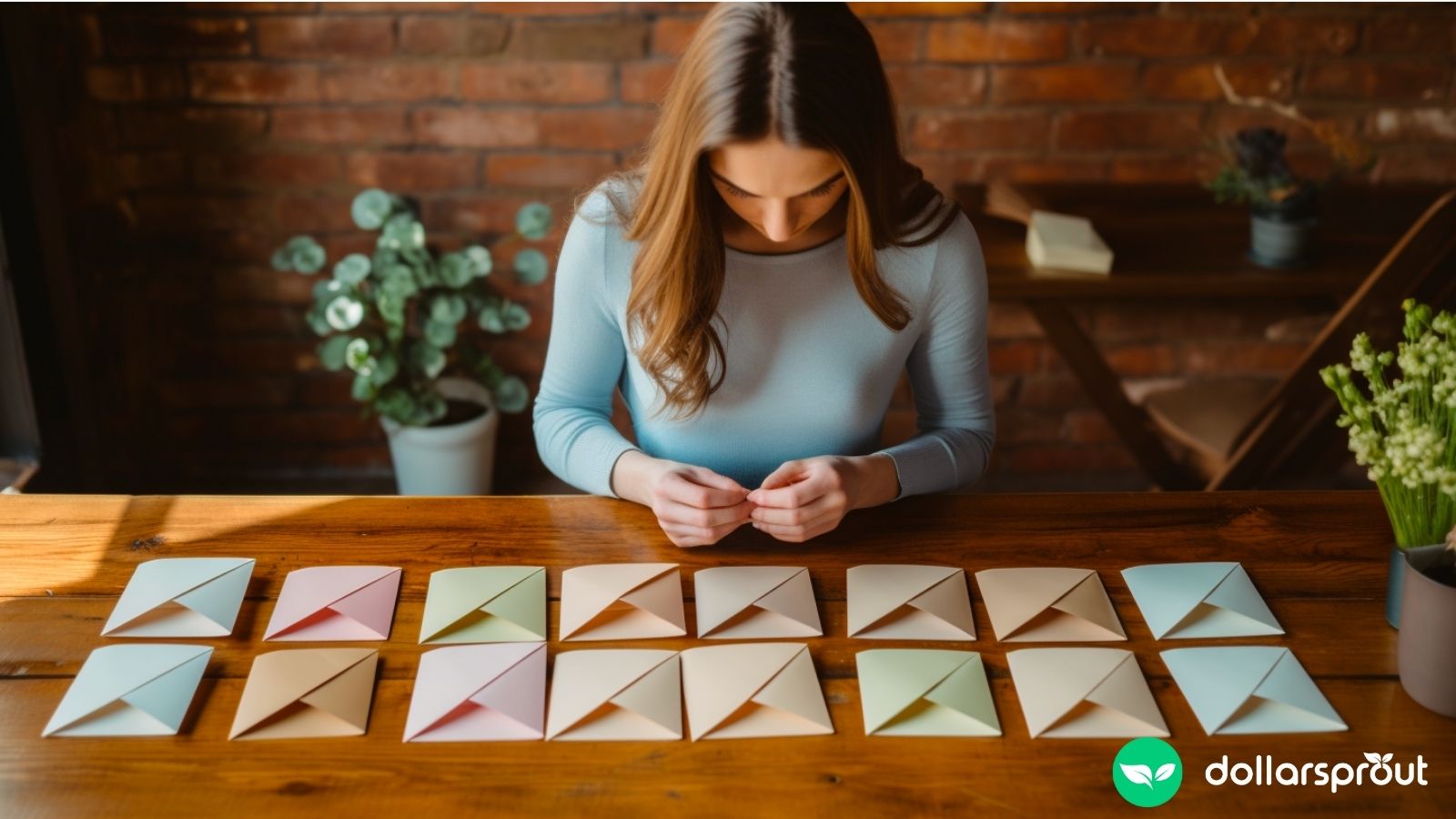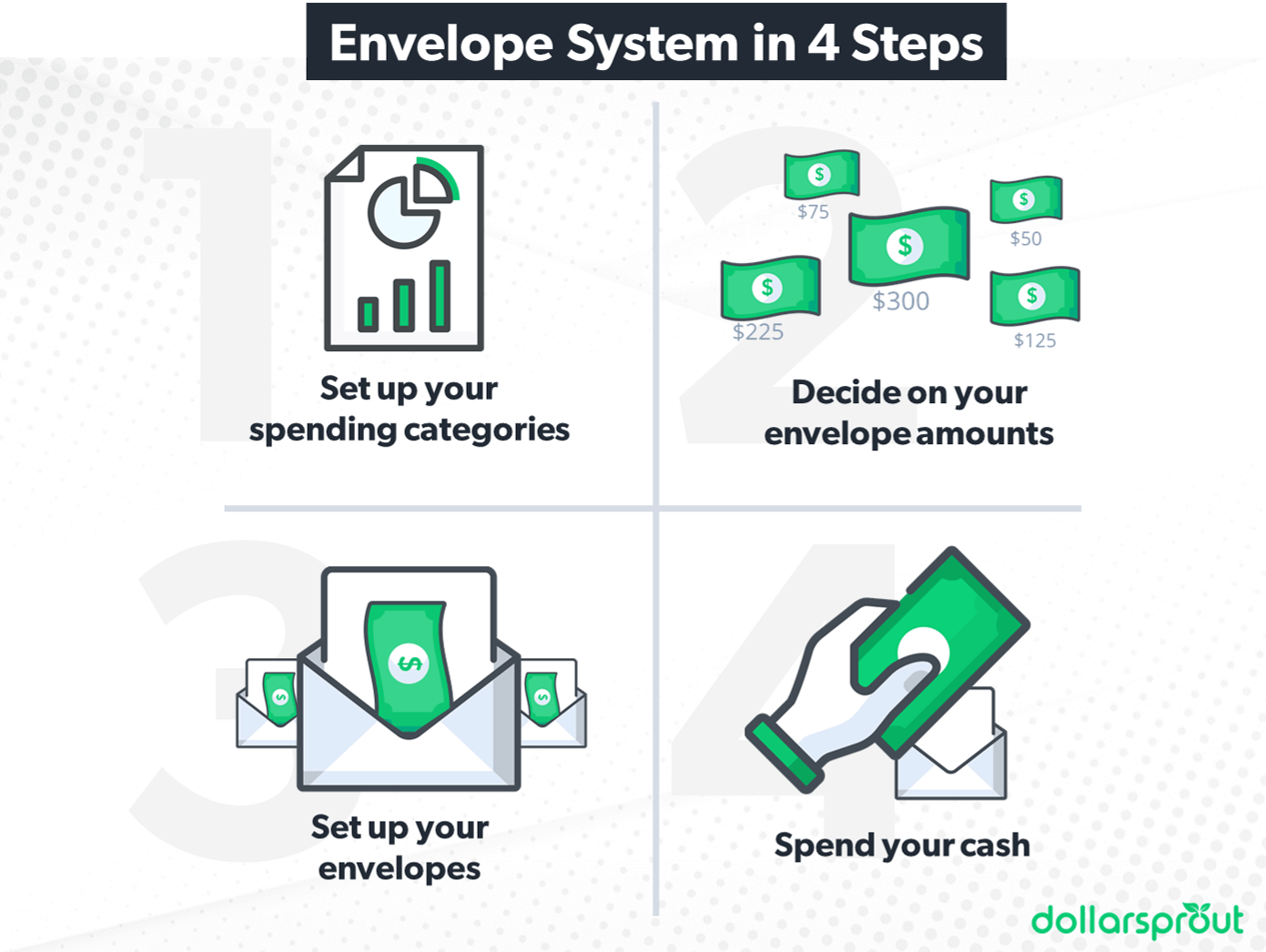What Is the Cash Envelope System and How Does It Work?
Our readers always come first
The content on DollarSprout includes links to our advertising partners. When you read our content and click on one of our partners’ links, and then decide to complete an offer — whether it’s downloading an app, opening an account, or some other action — we may earn a commission from that advertiser, at no extra cost to you.
Our ultimate goal is to educate and inform, not lure you into signing up for certain offers. Compensation from our partners may impact what products we cover and where they appear on the site, but does not have any impact on the objectivity of our reviews or advice.
The cash envelope system can help someone who wants an easy, low-tech approach to budgeting. All you need to get started are some mailing envelopes, a pen, and your cash.

Some of the links on DollarSprout point to products or services from partners we trust. If you choose to make a purchase through one, we may earn a commission, which supports the ongoing maintenance and improvement of our site at no additional cost to you. Learn more.
Creating a budget is the foundation for financial wellness.
But making a budget can be difficult, especially if you’re not tech-savvy and don’t like updating spreadsheets.
The cash envelope method can help people who want an easy, low-tech approach to budgeting. It doesn’t require you to register for any apps or pay for software. All you need to get started are some mailing envelopes, a pen, and your cash.
Not only is it inexpensive to use, but this system can help curb your spending and keep you on track. That’s because studies show that consumers spend more when using credit cards compared to paying in cash.[1]
Using cash envelopes can be the easiest budget to use, especially if you find yourself frequently overspending.
What Is the Cash Envelope System?
The cash envelope system turns the budget you made from an abstract concept to a tangible one with the use of physical envelopes. It’s been around a while but was popularized in the last few years as an instrumental part of Dave Ramsey’s Baby Steps.
The way it works is you withdraw a fixed amount of cash from your bank account and divide it into categorized envelopes based on how much you’ve budgeted for each item.
Label each envelope with budget categories such as groceries, restaurants, gas, and entertainment. The only categories you should use envelopes for are the ones where you normally pay, or could potentially pay, in cash. For example, if your utilities are usually paid online, you would continue to pay those directly from your bank account.

How to Use Money Envelopes
One of the big advantages of the cash envelope system is that you can only spend what is in your designated envelope for that month, week, or pay period. To make the system work, you stop spending money from that category when the envelope runs out.
1. Choose your cash envelope categories
There’s no right answer for which categories are best to use for your cash envelope system. It’s important that you tailor the system to your needs, and you should do whatever makes sense for your financial situation.
One practical way to get started is to pick a few categories where you have problems staying on track with your spending and use those for your cash envelopes. For instance, if you tend to go over your dining out budget, you can do a cash envelope just for that line item. Start with a couple envelopes and add more as you get the hang of the system.
2. Decide on your envelope amounts
How you budget the money in the envelopes depends on your paycheck frequency or your overall budgeting strategy. If you get paid twice a month, you can fund your cash envelopes when you get your paycheck.
For example, if you budget $400 a month for groceries and get paid twice a month, you’ll put $200 in the grocery envelope each paycheck. If you get paid weekly, you would put $100 in the envelope every week.
Base your envelope amounts on your current budget. Try to account for any extra or irregular spending such as lunch out with a friend so you have enough money available.
Related: How to Save Money on Groceries
3. Set up your envelopes
Once you’ve decided on the amounts for each category, it’s time to set up your envelope budget system. All you need are envelopes and something to write with.
You can buy a box of envelopes from the dollar store and write your categories on them. Using color-coded envelopes makes this system a little easier and more enjoyable. If you have construction paper around the house, you can try to fashion your own simple envelopes.
Since many greeting cards come with different color envelopes, you can also collect some from the next round of birthday or holiday cards and use them as your cash envelopes.
Once you have your envelopes, put the allocated amount of cash into each one. Try to keep all of the envelopes in one spot in your house, preferably near your keys or purse. This way, you remember to take them with you when you leave.
4. Spend your cash
Once you have your cash envelope system set up, you’re ready to spend the money. For many people, this is the most difficult part at first because you can only use the funds inside your envelope for their designated purpose.
You’ll need to get in the habit of planning so you can have the right envelope on hand. What happens if you head to the grocery store and forget your envelope in the car? Instead of borrowing money from a different envelope, or using your debit or credit card, go back and get the right one. This system only works if you adhere to it.
When doing an activity or buying groceries, track your expenses. Check your envelope before you leave the house to see how much cash you have left. As you’re putting items in your grocery cart, keep a tally with a calculator. Staying on top of your purchases will prevent you from having to put things back when you get to the checkout lane.
It’s also handy to keep the receipts in each envelope so you know where the money went. This is good for staying on track, and it can help you figure out where you’re spending your money and how to budget accordingly.
It’ll take practice, but once you get it down, using your cash envelopes will be second nature.
Pros of the Cash Envelope System
In addition to being simple to set up and use, there are several benefits to using the cash envelope system.
Stay on track with your budget. Because you can only spend the money inside each envelope, the cash envelope system helps you stick to your budget. You won’t go over budget unless you cheat the system.
Fewer overdraft charges. Staying within your budget also helps prevent overdraft charges. Since you’ve already planned out your spending for the month, you know you have the money in your account and envelopes to cover your bills.
Helps curb overspending. If you struggle with overspending, cash envelopes can often help this issue. You can only use what’s inside each envelope, and you can’t borrow from other envelopes, which keeps overspending in check.
Forces discipline. Only spending what’s in your envelope takes discipline and restraint. You may notice once you use cash envelopes that this translates to the rest of your finances, helping you cut back on spending in other ways.
The habits you develop from using the envelope system build on each other. If you’re looking for a way to change your behavior with your money, this is a good method to try.
Cons of Using Cash Envelopes
While there are plenty of positives to using envelope budgeting, the system is not for everyone.
Can be inconvenient. Carrying several envelopes of cash around can be awkward. You need to make sure you always have the right envelope with you. Also, there are some retailers that don’t take cash, which can be a problem.
Confusing at first. Another downside is that using cash only can be confusing when you first get started. If you have several envelopes, you will have to juggle them and make sure you’re using the cash from the correct one. That’s why it helps to make the envelopes look different. Put food stickers on the grocery one or make the entertainment one a fun color.
No credit card rewards. Using the cash envelope system means you won’t earn credit card rewards on your purchases. If you’re used to getting airline miles, hotel points, or cash back, this can be a major drawback.
Hard to keep track. While you can only spend what’s inside each envelope, you may forget to keep track of how you spent it. This means you may have a difficult time figuring out where your money went at the end of each month, especially if you’re not good at remembering to save receipts.
Everyone must be on board. If you have a significant other, they would have to agree to use the envelope system. This means that if you ask your spouse to make a grocery run, they would need to remember to bring the cash envelope to pay for the purchase. If they forget, you risk going over budget or even overdrafting your account.
If you’re looking for a convenient budgeting system that easily tracks your spending, the cash envelope method might not be for you.
View this post on Instagram
Cash Envelope System FAQs
Cash envelopes can be a difficult system to use, especially if you’re used to swiping your credit card everywhere you go.
What happens if I spend all my cash?
If you spend all of your cash, then it’s gone. It can be tempting to shuffle cash between envelopes if you spend more in one category over another, but for this system to work, you can’t borrow from other envelopes.
There’s also no cheating by using a debit or credit card. The point of using cash envelopes is to stay on budget. This means you’ll need to make a plan and ensure you have enough to cover your needs for that month.
If you run out of restaurant money, you don’t get to go out. Just say no and eat leftovers or invite your friends over to your house. Running out of gas money? Limit your trips, run errands on a bike, ask to go with a friend, or carpool to work. Figure out creative ways to stretch your money when you’re running low on cash.
Can I still use cash envelopes if I do everything online?
Using this system works best when you can pay cash for goods and services. If you do everything online, you can still use the concept, but it requires more discipline.
You can use envelopes to track how much you spend in each category. Write the amount you have budgeted for the month at the top of your envelope and itemize each purchase underneath. It’s like balancing a checkbook. Just subtract each purchase from your balance.
What if I have money left over at the end of the month?
Having money left over in your envelope at the end of the month is a great feeling. You can either roll the money over into next month’s budget or splurge on something fun.
It’s OK to reward yourself by going to the movies or buying a new shirt if you have money left over. This will keep you motivated to stick to your budget and only spend what you have set aside for each category.
Celebrating the little wins along the way has a positive psychological effect. It will help you keep going even when you’re frustrated and want to give up.
Related: 8 Best Budgeting Apps For Every Type of Budgeter
Money Envelopes: The Enemy of Overspending
When you use a credit card, it can be easy to swipe and forget. Looking back at your statements, you may wonder where your money went each pay period. With cash envelopes, you know that whatever you spent was already part of your monthly budget plan.
They provide a physical way to curb overspending by limiting your funds to only the budgeted amount in each category. This makes it a great way to teach yourself discipline and stay on track financially. Cash envelopes may seem like a simple idea, but they can be a powerful way to take control of your spending.





